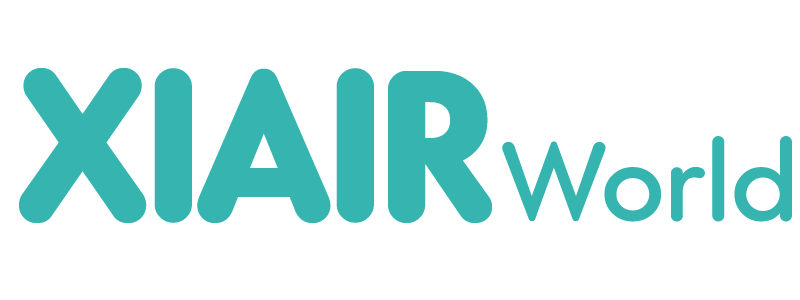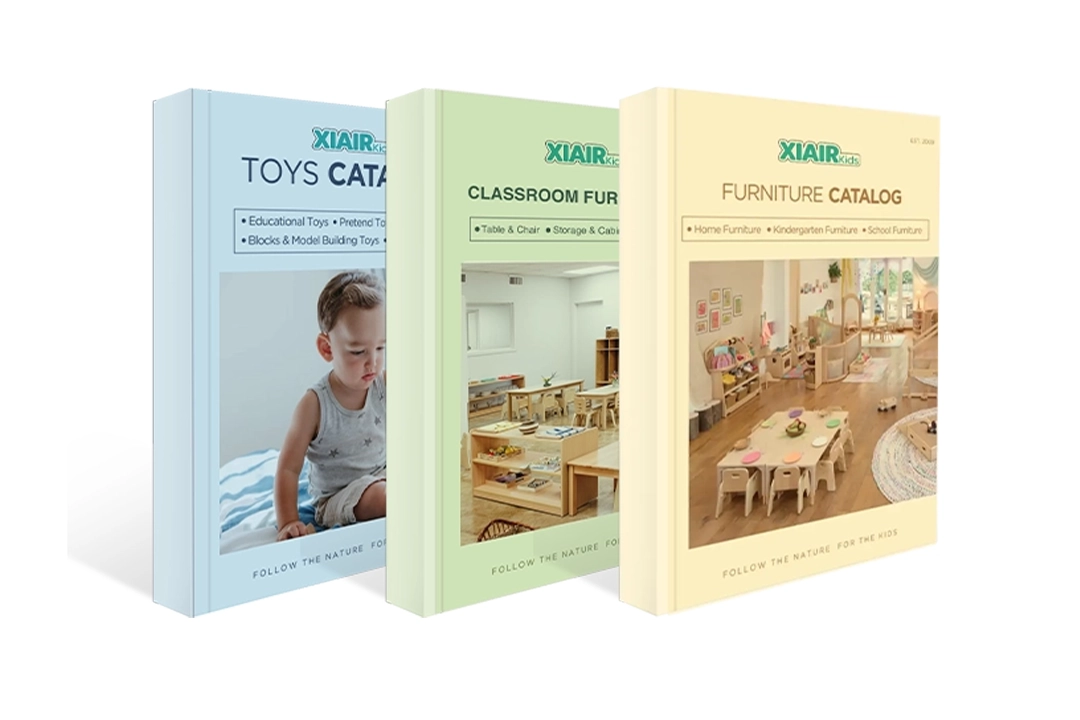What’s the difference between preschool and pre-k?
Parents often face this question as their child turns three or four. At first glance, the two terms seem interchangeable, but in early childhood education, they refer to different stages of learning and development.
Who is preschool for, and who is pre-k for?
Preschool usually welcomes children beginning at age three, while pre-k is designed for older four- and five-year-olds preparing for kindergarten.
Why does this matter?
The choice shapes how children learn social skills, handle routines, and develop early academic readiness. A child placed in the right program can thrive; a mismatch may leave them under- or over-challenged.
This guide breaks down preschool vs pre k similarities and differences, explaining age ranges, learning goals, classroom setup, schedules, and costs, so families can make informed decisions.
Understanding Preschool
Preschool is often a child’s first step into a group learning environment. Most programs accept children around ages 3–4, though some begin earlier. The purpose is not to teach academics in depth, but to help children:
- Explore through play – painting, building blocks, simple games, music, and movement.
- Develop social and emotional skills – learning to share, take turns, and work with classmates.
- Get used to routines – circle time, snack breaks, and short teacher-led activities.
- Practice basic concepts – recognizing colors, shapes, numbers, and sometimes letters.
Preschool schedules vary. Some programs run a few hours each morning, while others offer full-day care with naps and meals. Parents comparing preschool vs pre k should note that preschool remains play-centered and flexible, making it ideal for children who are still very young or new to structured settings.
Understanding Pre-K
Pre-Kindergarten, or pre-k, is the next step for children closer to ages 4–5. Unlike preschool, pre-k has a more structured focus on school readiness. Teachers plan activities that build the skills children need to succeed in kindergarten, such as:
- Early literacy – recognizing letters, phonics, and writing their names.
- Math readiness – counting objects, identifying patterns, and simple problem-solving.
- Longer attention spans – listening to a story for 15–20 minutes, following multi-step directions.
- Bağımsızlık – putting away materials, managing personal belongings, and handling transitions.
Most pre-k programs run on a full-day school schedule and may follow the public school calendar. Families comparing pre k vs preschool age should remember that pre-k is meant for children who are almost ready for kindergarten, both academically and socially.

Preschool vs Pre K Similarities
Even though preschool and pre-k are different stages, they share important similarities. Both programs are designed to help children grow beyond the home environment and prepare for the school years ahead.
In both preschool and pre-k, children will:
- Learn in a play-based setting, where fun activities drive learning.
- Practice social-emotional skills, like cooperating, waiting for a turn, and resolving small conflicts.
- Build language and communication by listening to stories, singing songs, and talking with peers.
- Explore creativity through art, music, and imaginative play.
These shared features explain why many parents confuse the two. Both programs create safe, nurturing environments where children learn not just facts, but also how to function in a classroom community.
Preschool vs Pre K Differences
While preschool and pre-k overlap in many ways, the differences define their purpose. Understanding these distinctions helps parents avoid mismatches.
Yaş Aralığı
- Okul öncesi usually begins around ages 3–4. Some programs admit children slightly younger if they are toilet-trained.
- Pre-K is for ages 4–5, the year just before kindergarten. This is why parents often search for pre k vs preschool age—because the difference of even one year changes what children can handle.
Curriculum Focus
- Preschool curriculum: More relaxed, centered on exploration and early exposure to numbers, colors, and shapes. Learning often happens through games and play.
- Pre-K curriculum: More structured, with activities linked directly to kindergarten readiness. Children work on early reading, writing, and math skills.
Learning Goals
- Okul öncesi: Socialization, confidence, independence, and curiosity.
- Pre-K: Academic readiness, following school routines, and mastering foundational skills before kindergarten.
Öğretmen Eğitimi
- Preschool teachers may have early childhood certifications, but programs vary widely.
- Pre-K teachers are more likely to hold degrees in early childhood education and follow state standards, especially in public school systems.
Sınıf Ortamı
- Okul öncesi sınıfları are arranged for exploration: activity corners for art, blocks, dramatic play, and sensory tables. Furniture is simple and flexible.
- Pre-K classrooms feel more like mini-elementary schools: learning stations for reading, math, and science, plus circle time areas for group lessons. The setup encourages longer attention spans and more structured activities.
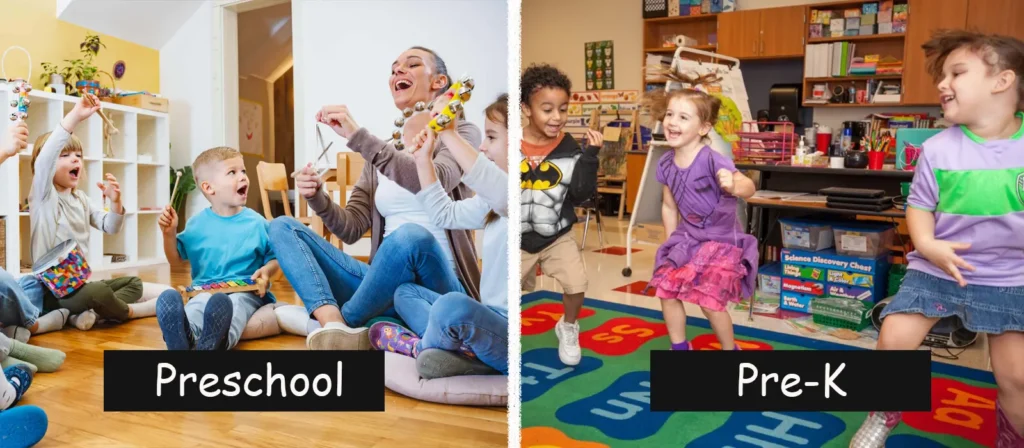
Daily Schedules in Preschool and Pre K
One practical way to see the difference between preschool vs pre k is by looking at their daily routines. The structure of the day reflects the program’s goals.
Typical Preschool Day (Ages 3–4)
- Arrival and free play – children choose toys or activities.
- Çember zamanı – a short group activity, such as singing or reading.
- Learning centers – art, blocks, dramatic play, sensory tables.
- Snack break – social eating practice.
- Açık havada oyun – playground or gross motor activities.
- Closing activity – story or song before dismissal.
Preschool days are usually shorter (often half-day), and activities are flexible to match young children’s short attention spans.
Typical Pre K Day (Ages 4–5)
- Morning meeting – group planning, calendar, weather, or daily theme.
- Focused learning blocks – small-group lessons in literacy, math, or science.
- Snack and recess – social time plus physical activity.
- Project time – guided activity, such as writing practice or art, linked to a theme.
- Story and discussion – longer listening and comprehension practice.
- Wrap-up and dismissal – review of the day, packing belongings.
Pre K schedules are usually longer (full-day or close to school hours) and more structured. Children are expected to sit for longer periods and complete teacher-led tasks, preparing them for kindergarten.
Parents comparing preschool vs pre k schedules should consider how much structure their child can handle.
Sınıf Mobilyaları ve Kurulumu
The design of a classroom reflects what children are expected to do there. A quick comparison of preschool vs pre k classrooms shows why furniture and materials matter.
Preschool Classroom Setup
- Mobilya: Small tables, child-sized chairs, cubbies, easels, and rugs for circle time.
- Zones: Play corners—blocks, pretend kitchens, art stations, sensory bins.
- Equipment list: Building toys, puzzles, picture books, crayons, and musical instruments.
- Amaç: Encourage exploration and creativity, while practicing independence.
Pre K Classroom Setup
- Mobilya: Similar child-sized furniture, but with more structured layouts.
- Zones: Reading corners, math and science tables, writing areas.
- Equipment list: Early literacy games, number cards, letter tracing boards, and group project supplies.
- Amaç: Support structured learning, group collaboration, and preparation for elementary classrooms.
For schools and suppliers, choosing the right preschool furniture or pre k classroom furniture is about balancing safety, durability, and learning needs. While preschool spaces look more like exploration labs, pre-k spaces feel closer to mini-classrooms.
Benefits of Preschool and Pre K
Both preschool and pre k provide strong benefits, but in different ways.
Benefits of Preschool (Ages 3–4)
- Builds social confidence – first friendships and group experiences.
- Teşvik eder yaratıcılık – open-ended play, art, and music.
- Teaches basic routines – lining up, washing hands, listening to short instructions.
- Destekler language growth – storytelling, songs, and conversation.
Benefits of Pre K (Ages 4–5)
- Strengthens academic readiness – early literacy and numeracy skills.
- Builds self-control – waiting for turns, following multi-step instructions.
- Teşvik eder independence – managing personal items, cleaning up, self-care.
- Prepares for kindergarten structure – longer lessons, group projects, and rule-following.
Think of it this way: Preschool develops curiosity and social basics. Pre K develops readiness for school routines and academics.
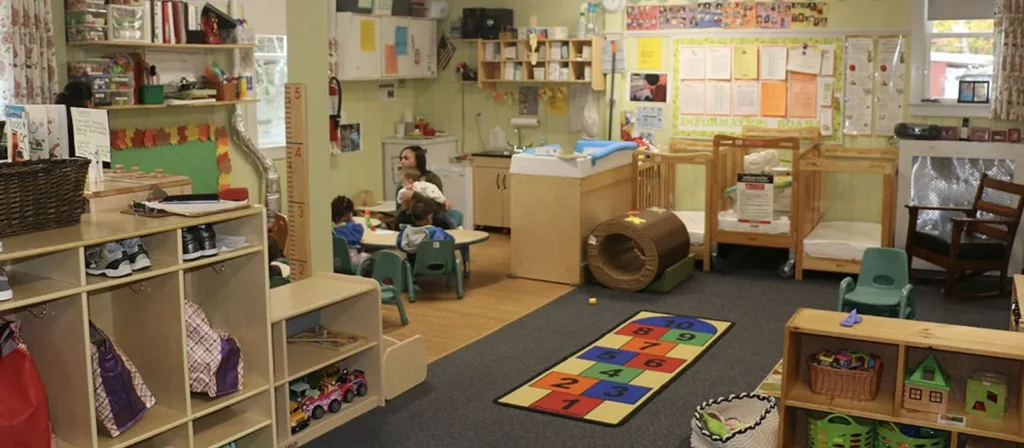
Preschool vs Pre K Cost
For many families, the decision between preschool vs pre k is shaped not only by age and readiness, but also by budget.
Okul Öncesi Maliyetleri
- Private preschool can range from $300–$1,000 per month for half-day programs.
- Full-day preschools may be as expensive as daycare since they include meals and naps.
- Public preschool (where available) may be free or subsidized.
Pre K Costs
- Public pre k programs are often free or very low-cost, especially if linked to the local school district.
- Private pre-k programs may cost $500–$1,200 per month, depending on location and hours.
- Extra costs may include supplies, uniforms, or activity fees.
Ppreschool may cost more unless your area offers public options, while pre k is often cheaper if provided by the school system.
Pre K vs Kindergarten
Parents sometimes confuse pre k vs kindergarten, but the two are distinct.
- Pre K (ages 4–5): A transition stage. Focuses on structured play, early literacy, and numeracy. Prepares children for routines.
- Kindergarten (ages 5–6): The first official year of elementary school. Stronger focus on reading, writing, math, and science. Longer lessons and more academic expectations.
If you want a full breakdown of how kindergarten compares to earlier years, check our guide: [Kreş, Okul Öncesi ve Anaokulu].
Transitional Kindergarten vs Preschool
Another term parents may hear is Transitional Kindergarten (TK).
- Okul öncesi: For ages 3–4, focused on play and early social learning.
- Transitional Kindergarten (TK): For children who just miss the kindergarten age cutoff. Usually, older 4-year-olds need an extra year before starting formal kindergarten.
- Goal of TK: To bridge the gap. It looks more like kindergarten than preschool, but it gives children more time to grow socially and emotionally.
Parents comparing transitional kindergarten vs preschool should think about age and maturity. TK may be better for older children who are not quite ready for kindergarten but are beyond preschool-level play.
Mistakes Parents Often Make
When choosing between preschool vs pre k, parents sometimes fall into common traps:
- Skipping preschool altogether – assuming pre k is enough. But preschool builds social confidence and routine skills that help later.
- Starting pre k too early – pushing a 3-year-old into a structured program before they are ready can cause stress.
- Choosing only by cost – cheaper isn’t always better if the program doesn’t match your child’s needs.
- Not visiting classrooms – the setup, teachers, and environment matter more than the name of the program.
Visiting programs in person, asking questions, and observing classrooms will help you avoid these mistakes.
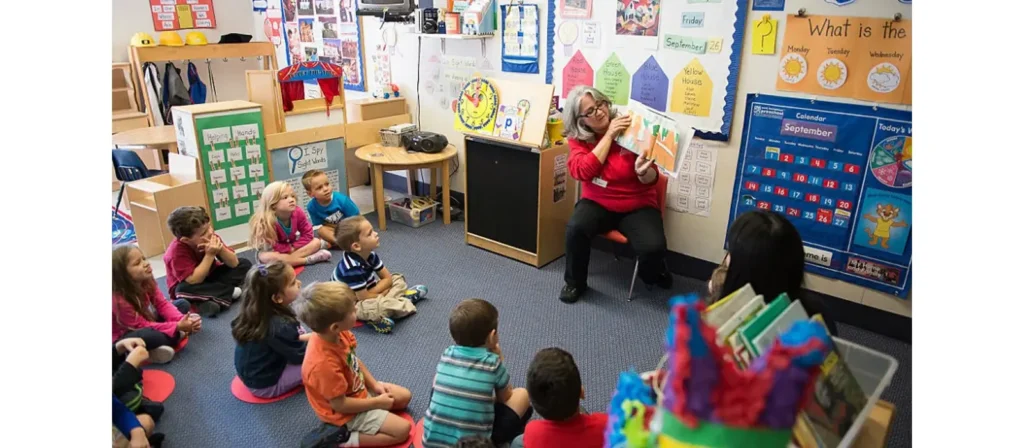
Çözüm
Deciding between preschool vs pre k is not about choosing which program is “better,” but which program is better suited for your child right now.
- Okul öncesi (ages 3–4) introduces children to group learning through play. It develops curiosity, social confidence, and a gentle sense of routine.
- Pre-K (ages 4–5) prepares children for the next big step—kindergarten. It strengthens early literacy and math skills, builds independence, and helps children adjust to longer, more structured days.
If your child is still very young, curious, and playful, preschool is the right fit.
If your child is approaching school age and showing readiness for academics and routines, pre-k is the logical next step.
Remember, both preschool and pre-k are valuable. Together, they form a natural bridge from home to kindergarten. What matters most is choosing the stage that aligns with your child’s age, development, and personality.
For a broader look at early childhood options, you may also find these guides helpful:
- [Kreş ve Anaokulu] – to understand how preschool differs from childcare.
- [Kreş, Okul Öncesi ve Anaokulu] – to see how all three stages connect in the bigger picture.
By making an informed choice, you give your child the strongest foundation for confidence, learning, and success in their school years ahead.
SSS
Is pre k the same as preschool?
No. Preschool is for ages 3–4, while pre k is for 4–5 year-olds preparing for kindergarten.
Can my child skip preschool and go straight to pre k?
Some children do, but preschool builds important social and routine skills. Skipping it may make the transition harder.
Is pre k mandatory?
In most regions, no. But public pre k is highly encouraged because it improves school readiness.
Which is better for social skills, preschool or pre k?
Both. Preschool focuses on first group experiences, while pre k strengthens teamwork and self-regulation.
What’s the difference between pre k and kindergarten?
Pre k is a preparation year. Kindergarten is the first official school year with academic standards.
How long are preschool and pre k programs?
Preschool is often half-day. Pre k is usually full-day and follows the school calendar.
What about preschool vs pre k vs kindergarten?
Preschool = early play and social skills.
Pre K = school readiness.
Kindergarten = formal academics.
